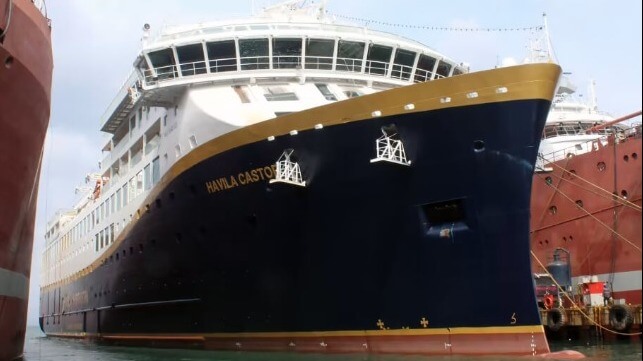Havila Takes Delivery of Second Ship with Shipyard Bridge Loan

Norway’s Havila Kystruten took delivery of its second passenger ship for Norwegian coastal voyages after completing temporary financing with the Tersan Shipyard in Turkey. The Norwegian company is continuing to look for alternatives to refinance its cruise ship operations and resolve uncertainties over its liability insurance to replace agreements with subsidiaries of GTLK after the leasing company was included in the EU sanctions against Russian interests.
The delivery of the second ship, Havila Castor, was completed as the company’s Havila Voyages was forced to cancel a second coastal voyage aboard its first ship, Havila Capella. They had been scheduled to depart Bergen, Norway on April 23, but the company said that due to the continued lack of approval from the authorities and thus uncertainty related to valid insurance on the ship, they would skip their second scheduled coastal voyage since GTLK was included in the sanctions. While the ship is registered in Norway and operates under Norwegian regulations, it is leased to the company from an Asian subsidiary of GTLK, which caused the unresolved questions about the validity of the liability insurance.
Because of the issues raised related to the sanctions, Havila took direct ownership of the second cruise ship. They reported that the ship which is valued at approximately $130 million was financed with equity and a three-month bridge loan for approximately $49 million from the Tersan shipyard and the shipyard's bank.
“This solution gives us time to find a proper refinancing of the ship, at the same time as it means that our company owns the ship from this date,” said Bent Martini, CEO of Havila Voyages during the handover ceremony on April 22. Martini said that Havila Voyages is already in the process of refinancing Havila Castor and the two remaining ships that will be delivered later this year, as well as Havila Capella.
“The largest challenge is, of course, Havila Capella since we lease it from GTLK Asia, which is now sanctioned. We are working on solutions here as well, to cut all ties to Russian and the sanctioned companies,” says Martini.
While the company continues to seek a resolution on its insurance issues, they are also working to prepare the Havila Castor to start operations from Bergen on May 10. The passenger ship departed Turkey on April 23 and is sailing to Bergen where she is expected to arrive tentatively on May 5. Because it is owned directly by Havila, the insurance issues that have stopped the Havila Capella from sailing are not a factor.
“The ship we have delivery of today is much closer to operational readiness for the coastal route Bergen - Kirkenes than Havila Capella was when she was delivered,” said Martini. He said the line had also learned from the start-up of its first vessel for the coastal route and although “time is short, we will be ready for the first voyage.”
The sanctions and issues related to the insurance coverage are only the latest in a series of challenges for the company to get its innovative vessels into service. They were initially delayed by problems with their shipyard contracts, changed shipyards, and then encountered delays due to the pandemic. The first ship entered service at the end of 2021, but the delivery of the Havila Castor along with her two sister ships still building at Tersan was recently delayed by issues with an electric motor supplied by a subcontractor.

that matters most
Get the latest maritime news delivered to your inbox daily.
“Since the ships are identical, Havila Castor has the same assets as Havila Capella. Among other things this means that the ships will be the first ships that can sail emission-free, at the same time as we are already sailing more environmentally friendly than has ever been done along the Norwegian coast,” said Martini.
Each of the four ships is designed to run on a hybrid-LNG power plant. While the primary fuel is currently LNG, the engines can use Liquid biogas (LBG) or it can be mixed into the LNG tank. The ships also are outfitted with a battery pack that weighs 86 tons and has an output of 6.1 megawatt hours (MWh). The ship can sail up to four hours on pure battery power, and the systems are prepared to use hydrogen or ammonia as fuel in the future.
